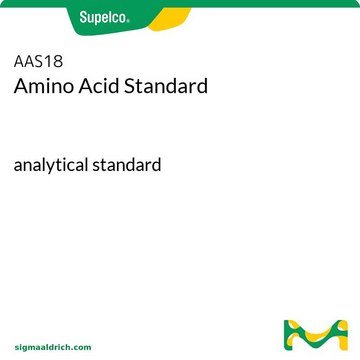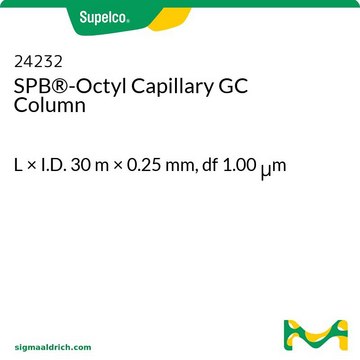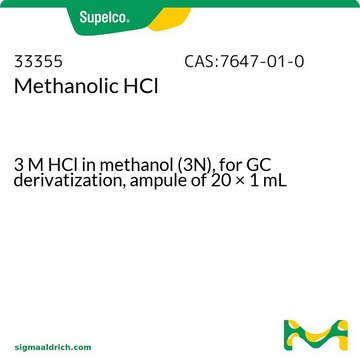40104-U
Methanolic HCl
3 M HCl in methanol (3N), for GC derivatization, pkg of 1 × 2 L
Synonym(s):
Methanolic HCl, Hydrochloric acid solution
About This Item
Recommended Products
grade
for GC derivatization
form
liquid
reaction suitability
reagent type: derivatization reagent
reaction type: Esterifications
packaging
pkg of 1 × 2 L
concentration
3 M HCl in methanol (3N)
density
0.79 g/cm3
storage temp.
−20°C
InChI
1S/ClH/h1H
InChI key
VEXZGXHMUGYJMC-UHFFFAOYSA-N
General description
Features and Benefits
- Derivatization of fatty acids, particularly volatile (short chain) fatty acids.
- Clean reaction (no side reaction) with volatile by-products.
- Provides clean, fast, quantitative derivatization.
related product
Signal Word
Danger
Hazard Statements
Precautionary Statements
Hazard Classifications
Acute Tox. 3 Dermal - Acute Tox. 3 Inhalation - Acute Tox. 3 Oral - Eye Irrit. 2 - Flam. Liq. 2 - Met. Corr. 1 - Skin Irrit. 2 - STOT SE 1 - STOT SE 3
Target Organs
Eyes,Central nervous system, Respiratory system
Storage Class Code
3 - Flammable liquids
WGK
WGK 2
Flash Point(F)
39.9 °F
Flash Point(C)
4.4 °C
Regulatory Information
Choose from one of the most recent versions:
Already Own This Product?
Find documentation for the products that you have recently purchased in the Document Library.
Our team of scientists has experience in all areas of research including Life Science, Material Science, Chemical Synthesis, Chromatography, Analytical and many others.
Contact Technical Service




![2-Oxo-7-azaspiro[3.5]nonane-7-carboxylate tert-butyl ester AldrichCPR](/deepweb/assets/sigmaaldrich/product/structures/823/725/568e418b-c181-481a-919a-1ff538a6cff0/640/568e418b-c181-481a-919a-1ff538a6cff0.png)





